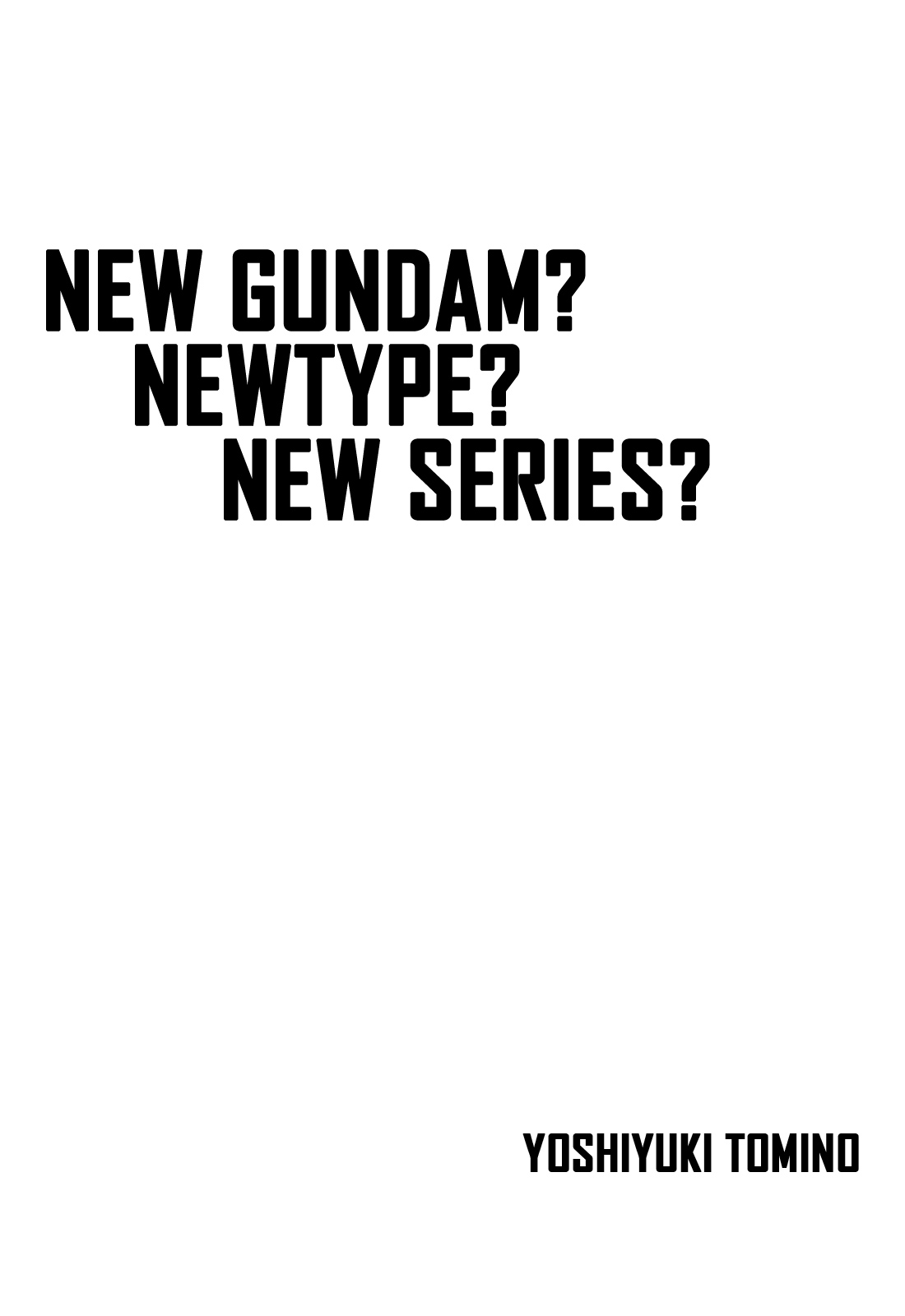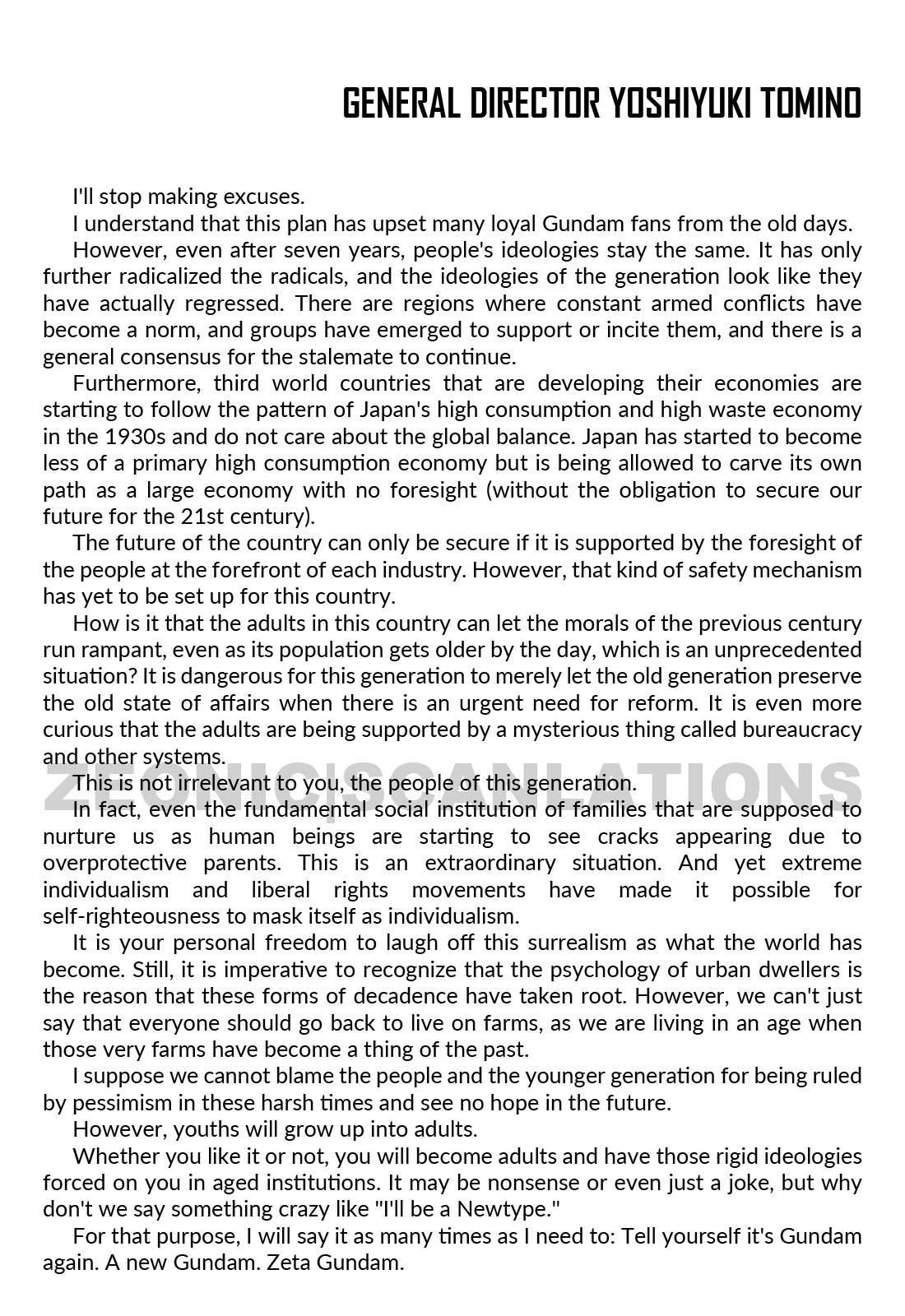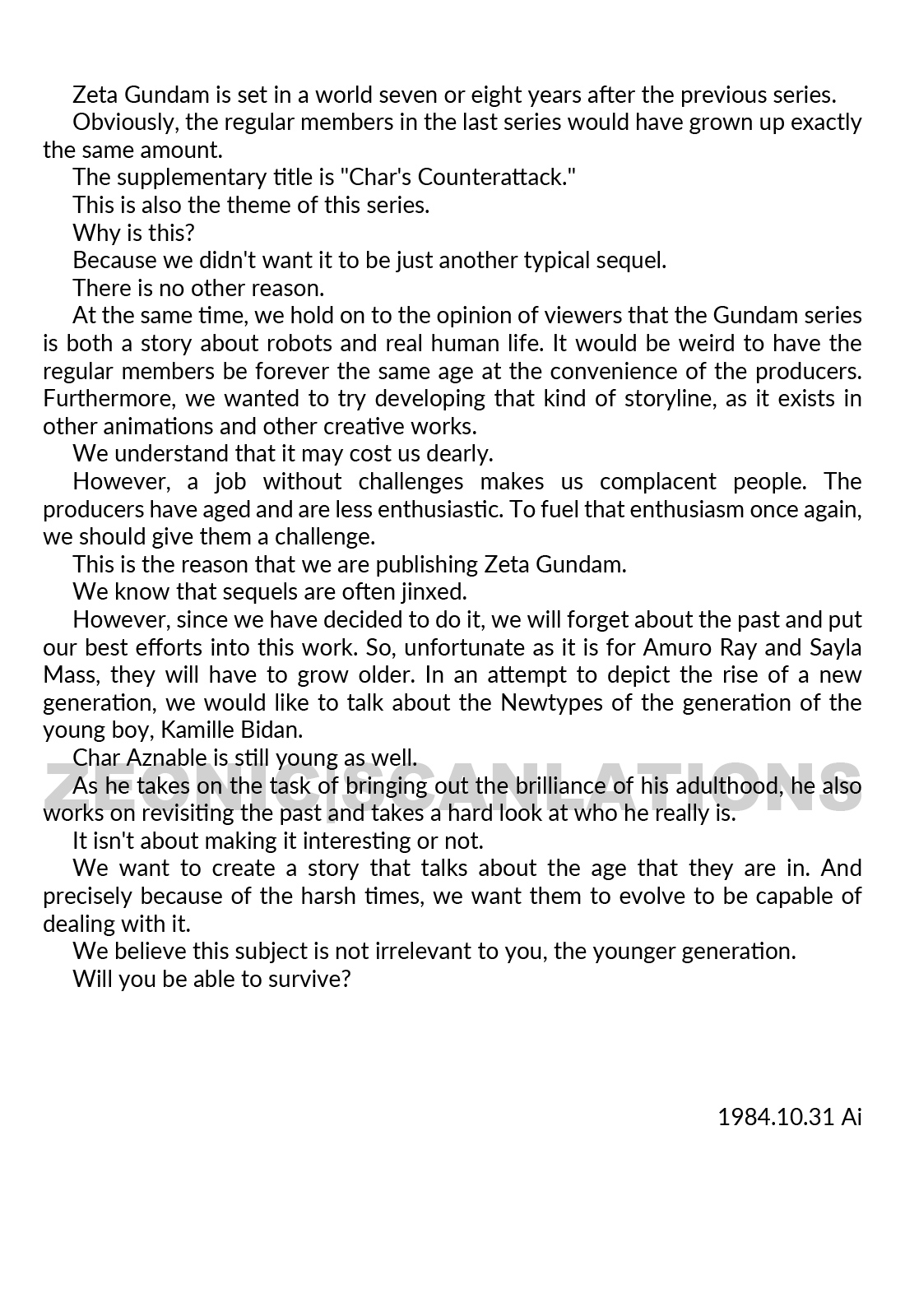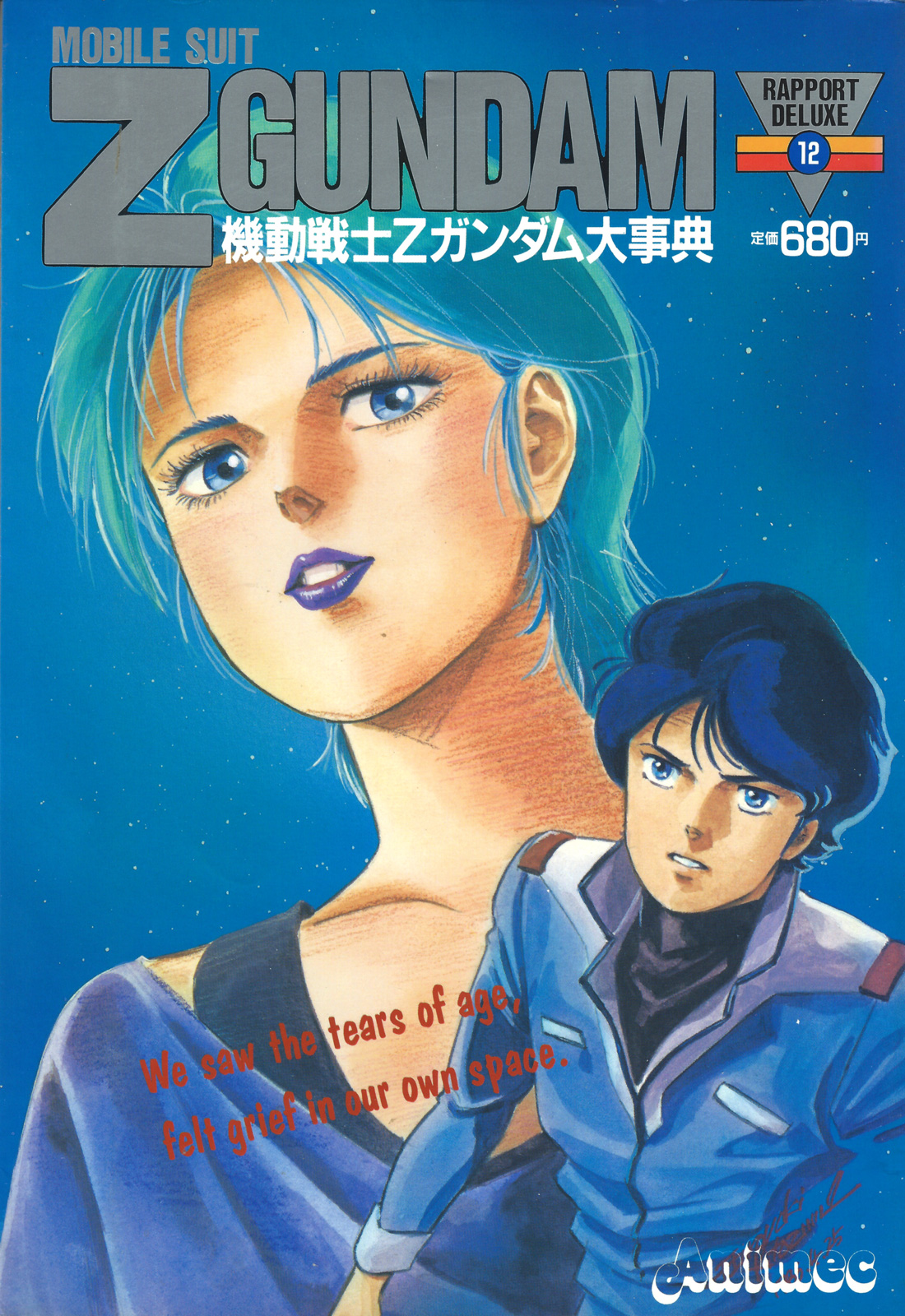[RAPPORT DELUXE] – YOSHIYUKI TOMINO INTERVIEW
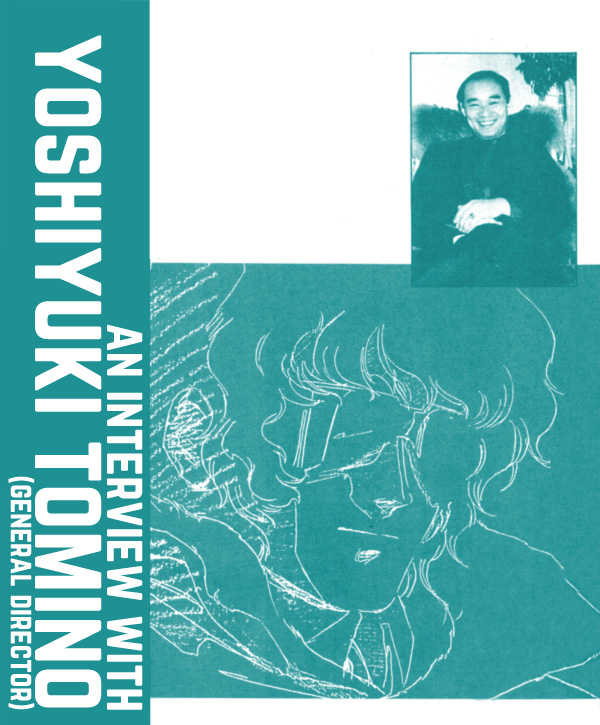
Since Z Gundam is a story about acknowledging reality,
that would have been Kamille’s breaking point.
Mobile Suit Gundam is said to be one of the biggest epochs in the history of TV animation. For Mobile Suit Z Gundam, the greatest concern with animation in 1985 is that the director who created the work, Yoshiyuki Tomino, would depict that world again seven years later. Still, when talking about these works, once cannot do so without Director Tomino. While that is something shared across all of his works, it is for Gundam series in particular. So, in this interview, the questions were posed with the idea of “the world after seven years” in mind.
■ ON EMMA AND RECCOA
First, there’s the heated discussion between Emma and Reccoa in episode 49, but what compelled the two women, and especially Reccoa, into being so affixed on their identities as ‘women’?
TOMINO: When it comes down to it, the two of them are talking about an identity that represents the idyllic image that men hold of women. To sum up why this is, Reccoa is a good example. She never makes the attempt to take a stand for herself even after how she was treated at Jaburo, and she maintains a state of denial by making excuses like “I’m looking for the man who will fulfill me”, and she ultimately ends up looking for a way to become dependent on a man. As a man, this is extremely gratifying to see. Emma is extremely similar to Reccoa, and I believe that the two characters are fundamentally the same in this sense.
At the same time, these kinds of characters are typically kept alive through the end of the story. However, in my case, I ended up killing them off.
In respect to Katz, I feel as though he is a character that grew in a way you couldn’t have imagined in the prior Gundam series. Couldn’t he have been a more innocent character?
TOMINO: No, definitely not. 7 years is plenty of time for him to change from his boyhood days. In Katz’s case, he probably lacked some self-restraint. Growing up with Hayato and Fraw as his adoptive parents, he got a sense that Hayato was too straightforward, and Fraw was too kind. Even after growing up in such an environment, you wouldn’t end up as high-strung as he did if you were to have a certain level of self-restraint. However, I believe that this is also something that’s common among today’s children.
In that case, from Char’s perspective, would a character like Haman be viewed the same as Katz?
TOMINO: You see, Haman had a sense of admiration for an ideal of a strong male figure. However, she wasn’t able to comprehend exactly what kind of person fit that archetype. That’s probably why she ended up being the woman that she was. Her approach of showing up after the conflict begins, then attempting to take advantage of either side ultimately makes her a petty villain. She wasn’t able to comprehend, or rather, she never really knew what a strong male figure was.
So when you simplify it, that’s really all that drives her character?
TOMINO: That’s correct.
■ ABOUT KAMILLE’S COLLAPSE
About Kamille Bidan, how did he end up the way that he did?
TOMINO: Personally, Zeta Gundam was a work where my intent was to create a story about perceiving reality. On that train of thought, Kamille had to end up the way he did. That was something I was thinking about even from the time when I had just started working on the series.
However, that doesn’t mean by any means that I dislike Kamille. If I didn’t like the character, there would be no way he’d be given so much screen time, and in the case of anime, it’s possible to flippantly change the personality of a character (Laughs). At the same time, by the end of the 2nd season, I felt he had to end up the way he did at the finale. Although it’s difficult tell whether it’s a good thing or a bad thing that he ended up the way he did, I felt that it accurately conveyed the kind of person that he was.
Now to explain why he has to break down in order for it to be a story about acknowledging reality. In other words, since Kamille was forcibly trying to exceed his limitations to obtain power, there was no way to let him obtain that which was beyond his capacity without there being some kind of consequence.
Also, since it was also a story about acknowledging reality for Char as well, I had to portray him in the troubled state you saw during the series. This is also reflective of my own personal struggles as well. Of course, even though this struggle is one of the themes, I do like to think that I’m not letting that become too excessive in driving the story.
■ WHEN IT COMES DOWN TO IT, AMURO IS A CHARACTER THAT HAS TO DIE
Next is a question about Amuro’s state of mind, but why didn’t he try to leave for space until the final episode?
TOMINO: That’s because I had no intention of sending him to space in the first place. I actually didn’t really want to put Amuro in too much at all. I wanted to just kill him off quickly, but I kept failing to do so.
So, as the director, you felt that Amuro should have died?
TOMINO: Yes, he should have died, and that’s something I still feel the same way about now. I would have really liked for him to die a pitiful death, but I couldn’t see someone like him dying pitifully. Char is the same in that sense, and these two really give me trouble to work with, let alone Mirai.
In spite of that though, you feel as though things pulled together nicely when Amuro got screen time.
TOMINO: That’s probably because of the impression left by the previous series. At the very least, between last year and this year, I’ve admittedly been in a position where I have been aging myself along with my creations, so I was definitely reluctant to do it.
Various things can cause little faults to really surface. I do feel that I want to make a clear distinction to create anime if I’m making an anime, and to make it a movie if it’s a movie. When it comes down to it, I think Zeta is fine as a standalone series. As such, I prefer not to include him in it.
However, I hope that if I’m able to finish things off with Amuro in ZZ, I would like to do so. At the same time, I’m not sure if he’ll even appear in ZZ, so I can’t really say much about it.
Now that you mention it, there weren’t any scenes where characters from the previous series gathered were together to have a conversation, but was there any particular reason for that?
TOMINO: The only reason for that was the budget. If there weren’t a budget limit, I would have had them get together as much as I wanted. A great deal of thought goes into constructing a plot. Unfortunately, it was inevitable that it ended up being that way.
Then you were a bit sad seeing how things played out that way?
TOMINO: No, that’s actually not the case. If you were to take Zeta as an example, if there weren’t certain limitations, and I was allowed to do anything I wanted, it actually could have resulted in something considerably worse. So it was good just the way it turned out. The only problem is likely the fact that you can still get a sense of those kinds of regrets. If the work as a whole had ultimately given a sufficient sense that you’d seen it all by the very end, then I think those kinds of lingering regrets could have been avoided. It really comes down those on the producing end falling short.
■ WHAT YOU SAW IN CHAR AND SAYLA
In respect to Sayla, she didn’t have any dialogue during the Dakar Speech in the TV version, but in the novel (Kodansha) version, there was a line where she remarks that “I may have to kill my brother”.
TOMINO: That was a line depicting how Sayla had seen through Char’s lies. She understood that the most troublesome figure making a mess of the entire situation was Char.
Does that mean that Dakar Speech was ultimately a mistake on Char’s part?
TOMINO: No, it wasn’t a mistake. I wanted to do something like that, regardless of what anyone said or thought. The moment you ask, “are you serious?!” is when it becomes a problem. In the recent incident with Ferdinand Marcos in the Philippines, he assumed the presidency in spite of the fact that he knew he would have to flee. That was because he wanted to say goodbye. It was amusing no matter how you think it, and I remember thinking that it would have been even cooler if he had announced the members of the Cabinet at the same time.
That’s what I think. But he ended up not doing that, instead settled for words of self-gratification to make a statement along the lines of “I was president to the very end”. I feel as though it showed how he was the kind of human being that was attracted to a very common ordinariness. When it comes down to it, perhaps people aren’t quite as level-headed as they think themselves to be? They tend to gravitate towards that which feels good.
Sayla likely saw through the dissatisfaction in how Char carried himself.
At the same time, Amuro was doing things like offering support in the assembly hall and confronting Char while he was troubled, but did he not pick up on the act as well?
TOMINO: Amuro likes Char. That’s why he understands him. Because Char was put in that kind of situation, he was attempting to try and survive making his own stance ambiguous. At first glance, it may look like a liberal position, but it shows how it’s easier to understand the battles of the far left and the far right. Being caught in that position, there aren’t many people who can find a clever way to survive. Unless of course, they happen to be a really rare kind of individual. In that sense, it would likely be cooler if he fell to the point where he took it upon himself to take out the Zabi family himself, but he doesn’t go quite that far. However, if he comes to feel that way in ZZ, he’d likely kill Haman, not to mention he would make himself an enemy of the Argama. Then Judau would likely condemn Char and then attempt to go to kill him. At that point, Char would likely come close to losing to Judau, and in his rage, he’d rid himself of his hesitations and become a truly strong Char. Of course, this is just one of the possible developments. However, he’s likely the type of man that will continue to lose. In that case, he should just become the president of the Earth Federation government, but he’s likely still too young for that position.
These aspects aren’t things I have a personal agenda for within the story, so that’ll probably be how it pans out.
■ REFLECTING ON ZETA GUNDAM
Lastly, now that you’ve finished Zeta Gundam, what are some of your personal impressions about the series?
TOMINO: Hmm, I learned two things in that there a whole ton of things you can do because it’s a TV series, and about the things that you absolutely can’t do on TV. I don’t think there are any other people who have had gone through both experiences in the way that I have. I was able to create something I enjoyed and was content with it. Then, in spite of the fact that I had already built something special, I felt frustrated by the notion of having to stop midway, so I was given the opportunity to focus for a year on the parts I felt were left short. Additionally, I was able to participate in my first yearly TV production where I was given the green light to do everything I wanted, even things that generally weren’t permitted on TV. Money couldn’t buy such a fortunate environment.
This is far worse than using a 2-3 billion yen to shoot a bad movie. The reason being that a TV series isn’t a one-and-done like a movie, and you can tell what’s going on with the production because it’s being made sequentially. In spite of that, you can use one season to do one thing, then make another season to do something else. In this process, it’s very evident what we’re doing on our end. In this case, it was clear that we were doing what we wanted.
After making Zeta this time, we received many different reactions from the viewing audience. Even if some of the comments were along the lines of “Tomino, what the hell is he doing!” When you receive letters of criticism like that, you know that people are watching, or that even if they aren’t watching, you know that there are going to be people that have various thoughts about the series. The volume of this kind of feedback is really immense. And in the midst of it, I was allowed to swim as I pleased. I’m extremely grateful for that, and for the fact that this kind of series was allowed to continue for a whole year. I feel as though I was at standing at the starting point in the midst of all of that. Of course, I let the younger people gradually take some of the reigns in many parts, but I have to say that I’m just so grateful to have been in a position where I was able to be at this starting point.
And this is the reason. This is the reason why it’s hard to tell whether this kind of tiredness is a good thing or a bad thing. When I think about what it must have felt like as a viewer to see what they saw coming from my end, I really just want to treasure the experiences I’ve been able to have for the past year. There is the problem of age, so I’m not entirely sure how things will turn out, but I am hoping to continue working at it. It’s an entirely different thing from the experience of a good movie, so I have to say that the different sponsoring companies involved really put up with a lot. I’m just very grateful. Anyhow, as far as my impressions go, these were the things that left the strongest impressions when reflecting back on this past year.
(Please note: Since the contents of this interview were recorded at the same time as the recording for the May edition of Animec magazine, there may be some overlap in the contents)
March 6, 1986, Office Ai

PUBLICATION INFORMATION
Publisher: Rapport
Released: 1986.08.25
Price: 680
Size: B5



